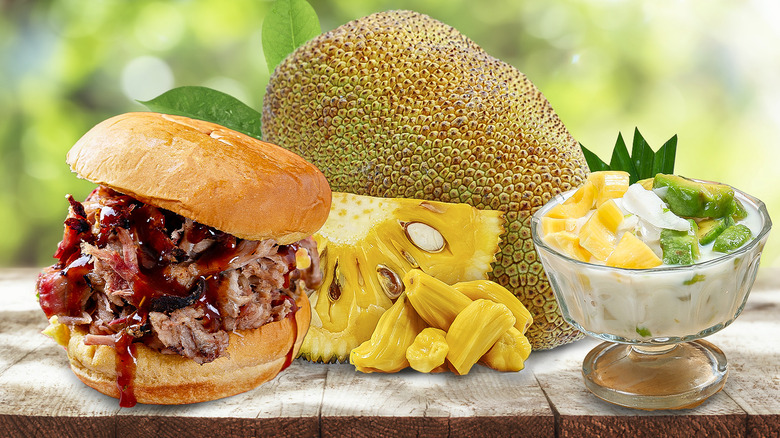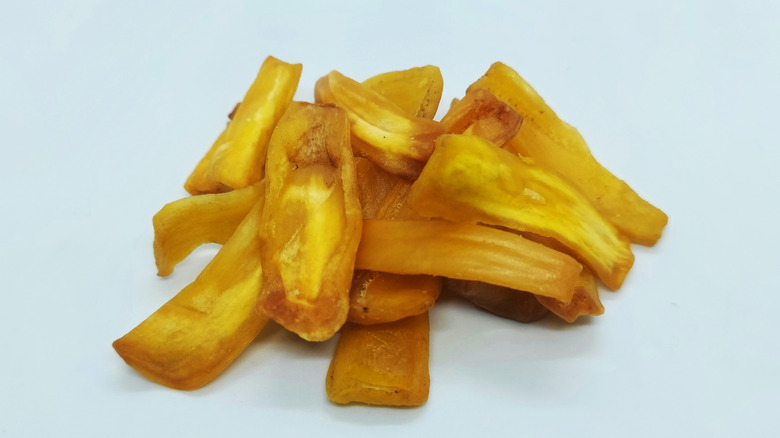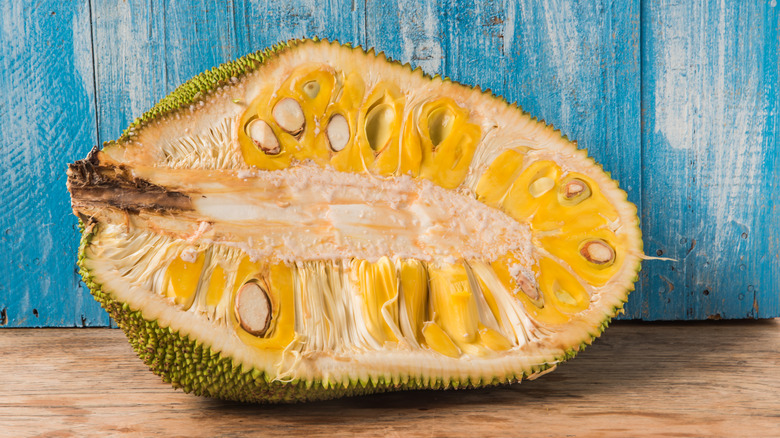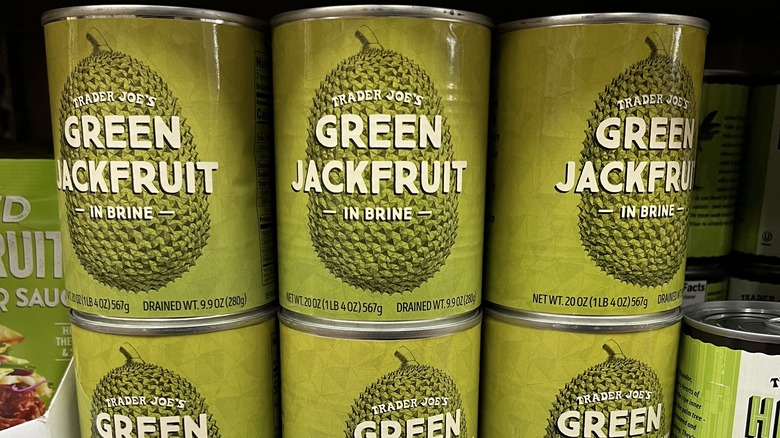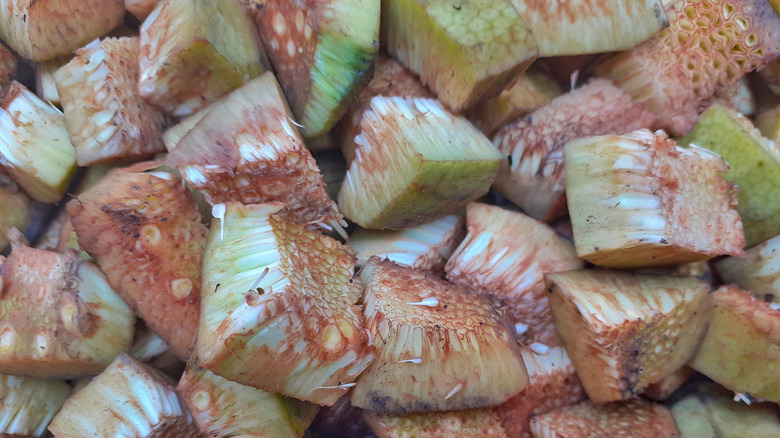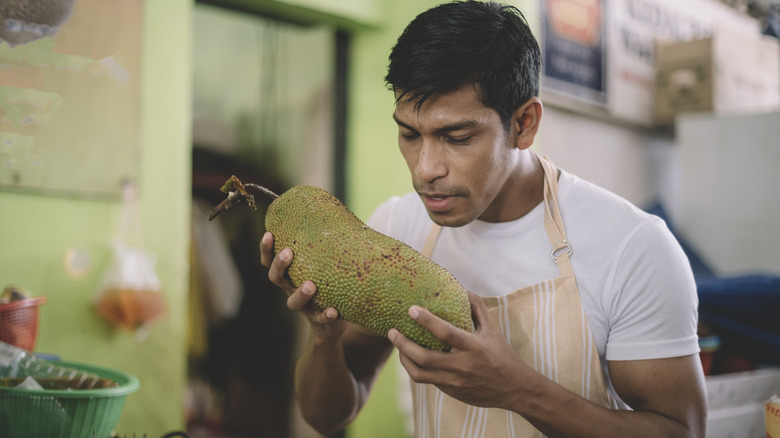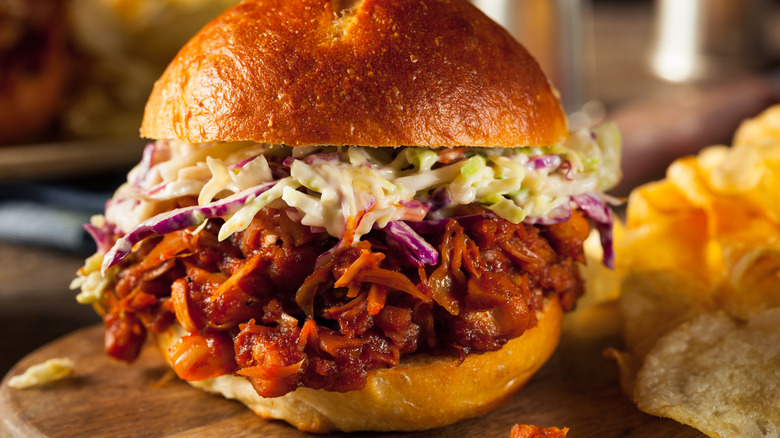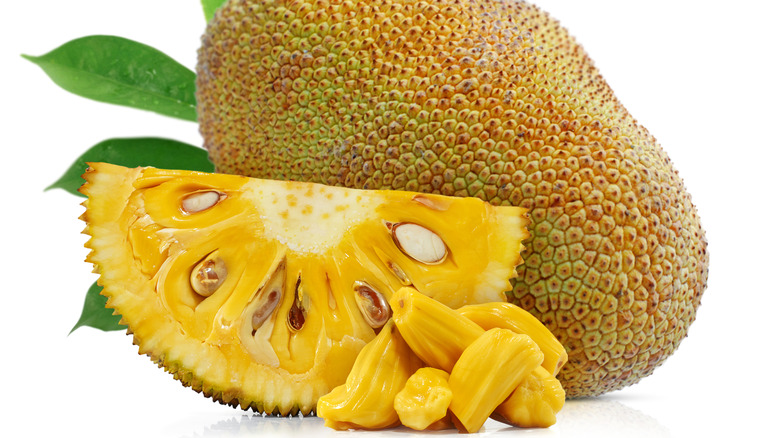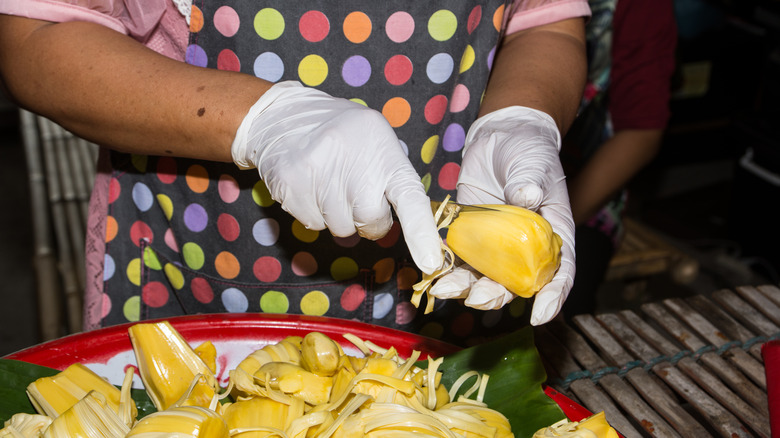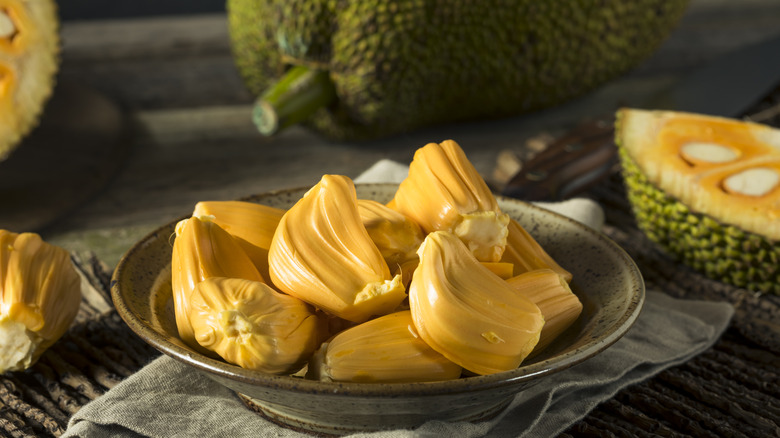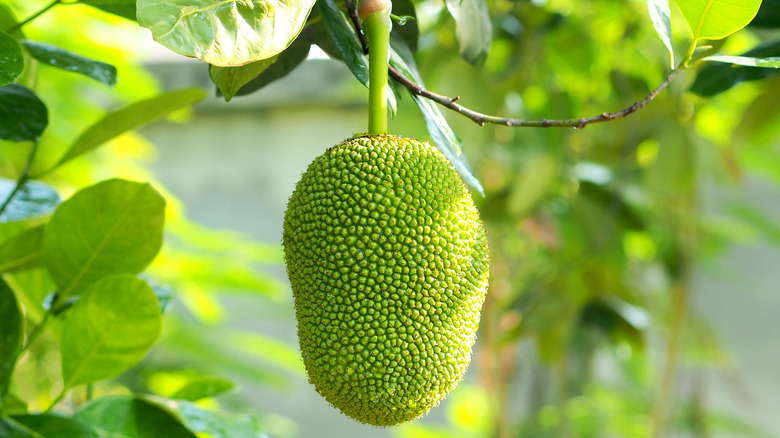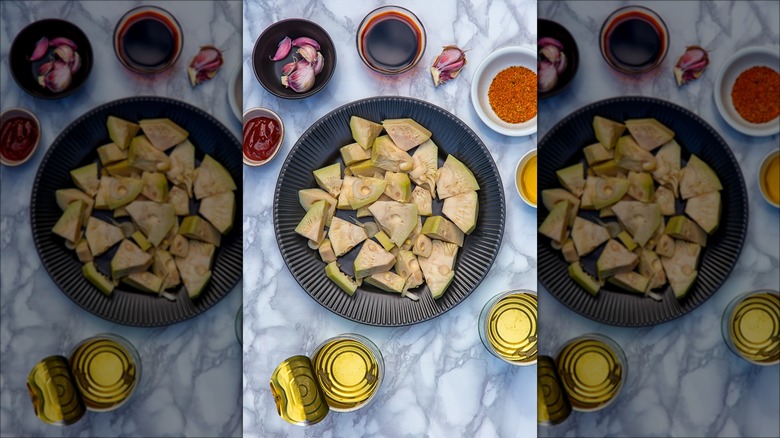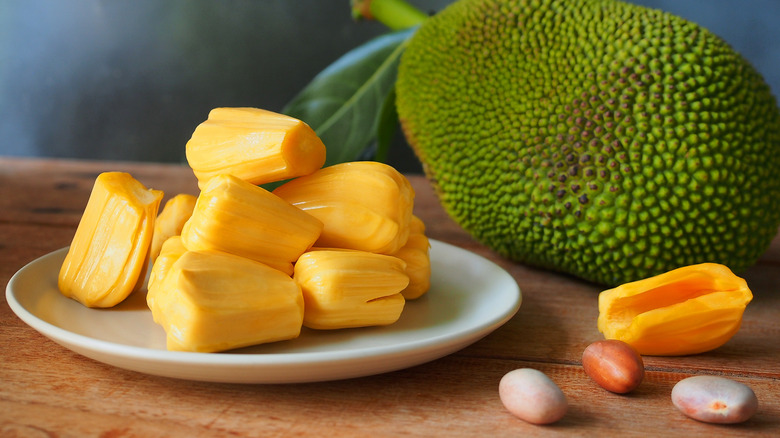13 Important Tips To Know When Cooking With Jackfruit
Five to 10 years ago, the odds of encountering someone in North America who ate jackfruit on the reg would be slim to none. The gigantic, bulbous fruit — native to India and Southeast Asia — was primarily contained to specialty food stores and the occasional restaurant menu. However, as interest in plant-based diets skyrockets, jackfruit is taking over the vegan world with its health benefits, versatility, eco-friendliness, and fantastic taste. Fresh, ripe jackfruit is still a little tricky to find in the United States, but canned jackfruit is readily available in most grocery stores these days.
Rich in protein, fiber, and important vitamins and minerals, jackfruit is prized for its ability to be cooked down and turned into something resembling pulled meat, making it a popular choice for those looking to reduce their meat intake but who still want to enjoy options similar to pulled pork, chicken, and beef. Although the taste definitely differs (most of the time, when jackfruit is acting as a meat substitute, canned jackfruit — which has an earthy, subtly sweet flavor — is used), it's a great textural experience, and marinades and seasonings really boost the flavor.
All that said, cooking with jackfruit varies greatly from cooking with most other meat, fruit, and vegetables. We've put together a handy guide to help you through the process.
1. Use dried jackfruit as a flavor booster
Canned jackfruit is likely the most prevalent form of this tree fruit, at least in the U.S. market, but jackfruit is also sold in fresh and dried form. Dried jackfruit is a pretty remarkable food. Nutritionally speaking, dried jackfruit doesn't contain as many vitamins, minerals, or protein as the canned version, but it comes with potassium, fiber, and is naturally vegan and gluten free. Dried jackfruit is made by drying out ripe, fresh jackfruit and subsequently has a mildly sweet flavor somewhat resembling pineapple.
With a chewy texture similar to other dried fruits like pineapple, mango, or apricot, dried jackfruit makes a great snack all on its own. Alternatively, consider using the dried fruit to add a little pizzazz to anything from cookies to trail mix to smoothies. One of dried jackfruit's coolest properties is that it can be rehydrated to the texture of canned jackfruit — just let it sit in boiling water for 5-10 minutes. Keeping dried jackfruit on hand is a good idea in case the day comes when you're planning on jackfruit tinga tacos for dinner and realize at the last minute you don't have any canned jackfruit in your pantry.
2. Don't fret about the fruit's seeds
In nature, jackfruits are huge — the tree fruits can grow as long as two feet and may weigh up to 40 pounds! Inside the fruit is sectioned off into smaller pods (also referred to as bulbs), each of which plays home to a large seed. Because of a jackfruit's large size, each fruit may contain anywhere from 100 to 500 seeds. In some corners of the internet, people claim that jackfruit seeds are toxic and to be thrown away immediately, but this is a myth about jackfruit you shouldn't believe. While raw jackfruit seeds do have harmful anti-nutrients that can cause health issues, like lectins and trypsin inhibitors, cooked seeds are actually fine to eat.
In fact, jackfruit seeds are bursting with nutritional benefits. The large seeds are rich in protein (uncommon for a fruit), fiber, magnesium, and other vitamins and minerals — just 100 grams of jackfruit seed contains 10% of the recommended daily value of potassium and 15% of vitamin C. Jackfruit seeds may be boiled, roasted, baked, or however you prefer to prepare them. As long as significant heat is applied, the seeds are safe to consume.
3. Rinse canned jackfruit before cooking
Canned jackfruit is the most readily available form of this giant tree fruit, at least in the United States. Canned jackfruit is much easier to work with than fresh fruit, which requires a lengthy and messy breakdown process — but there are still some best practices that are good to stick to when working with the canned version. The best way to prep canned jackfruit involves several steps, and rinsing is the first thing you should do after opening and draining the can.
Jackfruit is usually canned in brine or syrup to preserve its longevity, which can increase the sodium or sugar content of the fruit as well as affect its flavor. Rinsing the canned jackfruit eliminates the extra ingredients and leaves you with a product closer in texture, taste, and color to what you'd find in nature. This way, whatever seasonings or marinades you add to your jackfruit will easily shine without the distraction of syrup or brine.
4. Trim off the jackfruit's core
Canned jackfruit comes in large chunks reminiscent of the bulbs found in the ripe fruit. Although it's not always easy to discern in the can, some of the chunks may contain tougher pieces, which are parts of the fruit's core. If you're cooking jackfruit down, the texture of the core pieces softens and becomes barely noticeable. But if you're eating canned jackfruit raw, it's good to trim the hard pieces of the core away from the softer part of the fruit to maintain a nice, soft, even texture.
The bits of the core will also make it a wee bit more difficult to get that attractive, pulled meat look out of the jackfruit because the core holds the soft pieces of fruit together. When the core is trimmed, jackfruit is easily shredded with a fork or even your fingers to achieve the look and feel of pulled pork or chicken.
5. Make sure fresh jackfruit is ripe
Many recipes, especially savory ones, can easily be made with canned jackfruit — which is, without a doubt, much easier to find and work with. However, if you're a mad scientist in the kitchen and your heart is set on experimenting with fresh jackfruit, make sure you find the perfect one. There are a few ways to make sure your jackfruit is ripe and ready to rock and roll. Google search results for "fresh jackfruit" primarily pull up images of a green, spiky, prehistoric-looking fruit. While truly ripe jackfruit certainly retains these "Jurassic Park" vibes, jackfruit is actually ripe when it turns fully yellow.
Jackfruit's firmness offers another great way to test for ripeness. When lightly pressed with the fingertips, jackfruit should yield slightly without feeling mushy, sort of like an avocado — but if an indent is left by your finger when pressed, the jackfruit is past its prime. Finally, although this one takes a little practice and a sophisticated sniffer, scent can be used to gauge jackfruit ripeness. Ripe jackfruit is supposed to have a slight musky smell, while the unripe fruit has little to no scent at all.
6. Use canned jackfruit for savory recipes
There's a big difference between canned and fresh jackfruit. Ripe, fresh jackfruit has a sort of tropical flavor similar to pineapple or mango — in fact, Annie Ryu, CEO of The Jackfruit Company, told Parade magazine that, as legend has it, ripe jackfruit is supposedly the flavor that inspired Wrigley's Juicy Fruit chewing gum. On the flip side, canned jackfruit retains a slightly sweet flavor, but is not nearly as saccharine as its ripe counterpart. This is because jackfruit is usually canned when it's green and unripe, and its flavors are not quite fully developed.
This makes canned jackfruit a much better choice for savory recipes. Stick with canned jackfruit for BBQ sandwiches, "crab" cakes, stews, and pretty much anywhere else where jackfruit is being used in a savory way. What's more, pay attention to the way the jackfruit is canned — jackfruit canned in brine has a saline quality, but if the fruit is canned in syrup, its sweet flavor is amplified. You should be rinsing your canned jackfruit after opening anyway, but jackfruit canned in brine is the best choice for savory recipes.
7. Use fresh or dried jackfruit in sweet recipes
Jackfruit has a fantastic, tropical flavor that will transport you right to an island vacation when it's ripe and yellow. Since canned jackfruit is most often the unripe green stuff, if you want to experience fresh jackfruit, chances are you'll have to break it down yourself. Once you've properly broken down a jackfruit, the ripe, yellow flesh is best used in sweet recipes.
Fresh jackfruit makes an excellent addition to smoothies — unlike most other fruits, jackfruit contains protein, so it's a great way to incorporate some extra nutrients into your post-workout drink. Fresh jackfruit can also be used in cakes, fruit salads, or even pureed with ice for a jackfruit version of a piña colada. Alternatively, dried jackfruit can also be used in sweet recipes. If used as is, its texture will be chewy like most other dried fruit, making it a great addition to oatmeal cookies, parfaits, and smoothie bowls.
8. Wear gloves and oil your knife
Working with fresh jackfruit is quite an endeavor. Being the largest tree fruit in the world, there are a number of steps to take in order to break it down to the point where you have something to work with. One of the absolute best hacks for breaking down a jackfruit is oiling the blade of your knife and putting on kitchen gloves once the jackfruit is cut in half. The inside of a jackfruit is a sticky, gooey mess; and let's face it, if you're cutting open and dissecting a fresh jackfruit, you've got enough to deal with already.
The fruit's fibrous insides will cling to your knife and hands if you don't take the proper precautions. Use cooking oil, such as coconut or olive oil, to liberally coat the blade of your knife (take care not to grease the handle — you don't want to slip and cut yourself). Wearing gloves protects your hands from the fruit's sappy innards, and you can switch out the gloves as many times as you'd like during the process if it becomes too messy.
9. Learn how to break jackfruit down
Yes, breaking down a fresh jackfruit takes time and effort, but by studying the techniques, tips, and tricks beforehand, an amateur should be able to master this skill just fine. Begin by using a chef's knife to cut the fruit down to a size that's easy to work with — depending on how big the fruit is, this may mean cutting it in half, into quarters, or more. You'll find soft, sticky fruit inside — use your oiled knife to cut away the core until you can reach the fruit, then use your (gloved) hands to pull the fruit out in chunks.
The chunks are the fruit's bulbs or pods, and each one will contain a large seed. Remove the seed and put the seeds aside if you plan to use them later. This process can take some time depending on the size of your jackfruit, but in the end, you'll be left with a pile of ripe, juicy jackfruit ready for cooking. See? Not as intimidating as you may have thought. Many people learn best by seeing things in action, so if you'd like to see how it's done, we have a helpful YouTube video to get you started.
10. Know where to look for this fruit
Jackfruit is native to India and Southeast Asia, as previously mentioned, but with its popularity booming, it can now be found all over the world. In the United States, you can get your hands on canned jackfruit in just about any supermarket nowadays. Fresh jackfruit is definitely tougher to track down, but it can be found in the wild if you know where to look. Jackfruit can be grown in the humid, tropical climates of Florida and Hawaii, so if you live in one of these states, you may get lucky enough to come across these giant tree fruits at a farmer's market or grocery store.
If you're in one of the other 48 states, you're not out of luck. Jackfruit is shipped around the nation. And while you're unlikely to come across it at Aldi or Costco, keep your eyes peeled in specialty and natural food stores like Whole Foods and Sprouts. If you're not seeing fresh jackfruit in your area and really want to try it, you can order it online — just be aware that you're probably going to pay an arm and a leg.
11. Marinating and seasoning boost flavor
Plant-based cooking is often criticized for lacking flavor by those who don't know any better. Experienced plant-based eaters know that the items that make up the base for many a vegan meal, like tofu, tempeh, and yes, jackfruit, go from zero to 100 with seasonings and marinades. Jackfruit soaks up flavor like a sponge, so if you are looking for the best way to take it to the next level, look no further than your fridge and spice cabinet.
Dry seasoning can be applied to canned jackfruit directly and be good to go, as is the case with this plant-based chipotle jackfruit nachos recipe. You can use any spices you like with jackfruit, from smoky chile powder to warm curry to zesty lemon pepper. If you're using a marinade, allowing the jackfruit to marinate for at least 30 minutes will guarantee the best results. The longer the jackfruit sits in your BBQ sauce or carnitas marinade, the bigger, bolder, and better the flavor.
12. Keep and cook the jackfruit seeds
As mentioned, seeds from fresh jackfruit are perfectly safe to eat, as long as they're cooked first. The seeds are quite large, generally one to two inches in length, sort of like an avocado pit. Jackfruit seeds can be prepared in a number of ways, the two most popular being boiling or roasting. Boiling jackfruit is as simple as covering the seeds with water in a large pot. Allow the water to come to a boil, then let them sit in boiling water for about half an hour to soften. Once finished, the seeds' outer shell should be peeled before eating. Boiled jackfruit seeds have a deliciously soft and creamy inside.
To roast jackfruit seeds, first carefully remove the outer shell of each seed using a knife, coat them in salt and oil, and bake at 400 degrees for about 20 minutes for creamier seeds or a little longer if you want a dryer consistency. The end result should be nutty, earthy, and slightly sweet.
13. Store jackfruit properly
Whether you're going with canned or fresh jackfruit, it's important to store jackfruit properly just like any other food. If left in an unopened can, of course, jackfruit can remain in the pantry for months or even years, up until its expiration date. If you've used canned jackfruit to make juicy jackfruit tinga tacos or tangy North Carolina-style pulled jackfruit sandwiches and find yourself with leftover "meat," keep the excess in an airtight container in the refrigerator. It will keep its flavor and consistency for about a week in the fridge, or you can freeze it for up to three months.
If you are cooking with fresh jackfruit, you're almost certain to have leftovers. Fresh, cut jackfruit should not be left out at room temperature for more than a couple of hours, so once you're done with it, make sure to save any leftovers in an airtight container or wrap them tightly in plastic wrap and store it in the refrigerator. Fresh jackfruit has a similar lifespan as canned in the fridge or freezer — it'll last about a week in the fridge or up to two months in the freezer.
Static Media owns and operates Tasting Table and Mashed.
